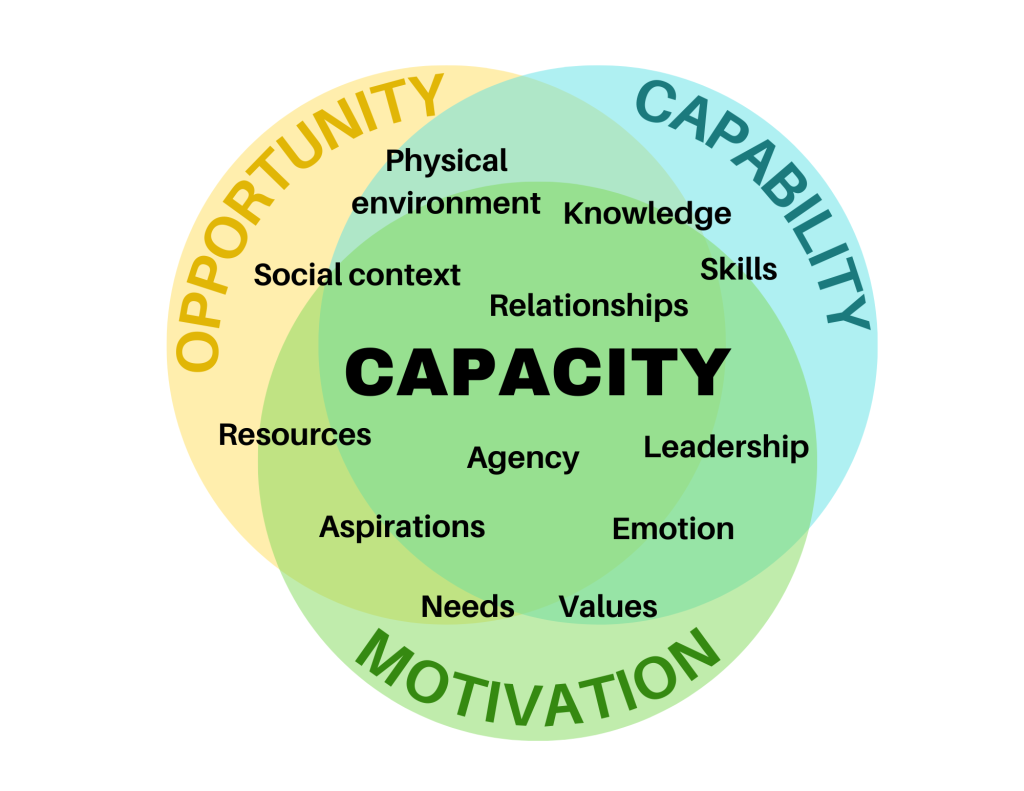Theory of Change
OVERVIEW
Our theory of change draws on scholarly literature that widely considers change to be a result of three major factors: motivation, opportunities, and capabilities. These three factors combine to yield capacity, which increases the likelihood of change. However, in order to move away from individualistic understandings of change, we wish to emphasize the importance of networks and relationships, and we view our theory as applicable to groups as well as individuals. In the case of groups, motivation, opportunities, and capabilities refer to those experienced by the group collectively. While still drawing on the literature, we also understand these three factors as overlapping, and we have changed our understanding of capacity to reflect an anti-ableist perspective.
CAPACITY
Capacity consists of three major factors including motivation, opportunity, and capability, which together make behaviour change more likely (Michie et al., 2011; Sridharan & Nakaima, 2019). These factors can be further broken down to include:
- Knowledge
- Attitudes
- Skills
- Aspirations
- Values
- Resources (money, people, networks)
- Leadership
- Physical, social, political, and cultural context
- Etc.

(Goodman et al., 1998; Mayne, 2015; Organizing, n.d.)
In the initial stages of organizing, an individual or group should prioritize relationship-building because this can increase many of the above factors at the same time (Organizing, n.d; Our Model, n.d). When the community then reaches a high enough level of capacity, they develop the power required to undertake new activities that were previously inaccessible. In turn, capacity-building creates momentum which allows a community to achieve increasingly meaningful goals (Organizing, n.d).
MOTIVATION
Motivation occurs when there is a need for change that aligns with one’s values, and external factors prompt or enable the actions required to make that change happen. In the context of organizing, storytelling is an effective way to articulate shared values and needs, which then motivates others to take action by eliciting their emotions (Organizing, n.d). It is also possible to increase motivation by educating others about the issue, exerting social normative pressure, or offering incentives (Stephan et al., 2016).
CAPABILITY
Capability encompasses the physical and psychological factors required to engage in a given activity (Michie et al., 2011). Usually, these factors involve having the necessary knowledge and skills, which can be achieved through research, training, continuing education, and relationship-building. When combined with the appropriate context and opportunity, capability provides an individual or group with the agency to control their behaviour and direct their actions effectively (Mayne, 2015).
OPPORTUNITY
Opportunity refers to the external factors (physical, social, political, cultural) that prompt the behaviour and/or make it possible (Michie et al., 2011; Stephan et al., 2016). This is crucial for sustainability because an individual or group might be highly motivated with the knowledge and skills required for a given action, but they are unlikely to maintain change in the long run without an enabling environment (Sridharan & Nakaima, 2019).
To some degree, it is possible to create one’s own opportunities by working to remove constraints, creating inclusive project governance structures, leveraging project relationships, and building a sustainable resource base (Stephan et al., 2016).
